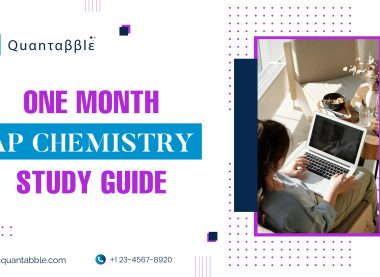A Complete Guide to IB Chemistry Internal Assessment: Everything You Need to Know
The International Baccalaureate (IB) program is renowned for its challenging curriculum, and the Internal Assessment (IA) in IB Chemistry is a critical component that allows students to demonstrate their understanding of the subject. In this comprehensive guide, we will delve into the various aspects of the IB Chemistry IA, offering insights and tips to help students navigate this demanding yet rewarding task. Chemistry is an interesting subject that investigates matter’s properties, composition, and reactions. The Internal Assessment (IA) is an essential component of the International Baccalaureate (IB) programme. It allows students to demonstrate their understanding of chemistry by applying it to a real-world problem or investigation.
The IA is graded on a 1–7 scale, with 7 being the highest possible score. For IB students, the Internal Assessment (IA) is an essential part of the chemistry course. It enables students to demonstrate their comprehension of the subject by applying their knowledge to a real-world problem or investigation. This section should give an overview of the research question or problem that the IA is investigating. It should have a clear hypothesis and any pertinent background information.
https://quantabble.com/tutoring-service/

Good IA:
The purpose of this IA experiment is to investigate the effect of various hydrogen peroxide concentrations on the rate of reaction with potassium iodide. This experiment is significant because it sheds light on the reaction kinetics of hydrogen peroxide and potassium iodide, as well as how their reaction rates vary with hydrogen peroxide concentration. Furthermore, this experiment is important for understanding the properties of hydrogen peroxide and its potential applications in various industries. The hypothesis for this experiment is that as the concentration of hydrogen peroxide increases, so will the reaction rate. This summary states a clear research question and the significance of the experiment. The hypothesis is also stated clearly and relevant to the research question. The introduction provides enough contexts to help the reader understand the significance of the experiment.
Bad IA Introduction:
In this IA, we performed an experiment to investigate the reaction between hydrogen peroxide and potassium iodide. We wanted to see how quickly the reaction would occur and how it would vary with different concentrations of hydrogen peroxide. We believe that this experiment is significant because hydrogen peroxide is used in a variety of applications and it is critical to understand its chemical properties. This introduction is overly brief and lacks detail. It lacks a clear research question or hypothesis, making it difficult for the reader to understand the purpose of the experiment. It also fails to explain why the experiment is significant, let alone how it relates to previous research or real-world applications.
Understanding the IB Chemistry Internal Assessment
The IB Chemistry IA is an independent investigation conducted by students under the guidance of their teachers. It contributes to 20% of the total assessment in the course and is an opportunity for students to showcase their scientific skills, critical thinking, and ability to apply theoretical knowledge to real-world situations. It provides an opportunity for students to demonstrate their knowledge of scientific principles, research methodology, and the ability to draw meaningful conclusions. The IA not only assesses academic performance but also develops skills necessary for future academic and professional endeavours. This guide delves into the complexities of the IB Chemistry IA, offering valuable insights to help students navigate the challenges and maximise their success in this important aspect of the IB programme.
Choosing a Relevant and Engaging Research Question
The first step in the IB Chemistry IA process is selecting a research question. This question should be relevant, engaging, and aligned with the course content. We recommend choosing a topic that genuinely interests you, as this will make the entire process more enjoyable and motivating.
Formulating a Hypothesis and Establishing Objectives
Once you have your research question, the next step is to formulate a clear hypothesis and establish specific objectives for your investigation. Clearly define the variables you will be studying and outline the methods you plan to use to collect and analyze data.
Conducting a Thorough Literature Review
A strong IB Chemistry IA includes a comprehensive literature review that demonstrates an understanding of relevant scientific theories and past research on the chosen topic. This section should provide a solid foundation for your investigation, helping you build a strong argument for your hypothesis. This section not only demonstrates your research skills but also positions your investigation within the broader scientific discourse. Emphasize the significance of each study, critically analyzing methodologies and outcomes. A nuanced literature review enriches your IA, guiding the formulation of a robust research question and setting the stage for a compelling scientific inquiry. Paying meticulous attention to this aspect ensures a well-informed and academically rigorous approach to your IB Chemistry IA.
Designing and Conducting Experiments
The experimental aspect of the IB Chemistry IA is a crucial element. Carefully design your experiments, ensuring that they are well-controlled and capable of generating meaningful data. Clearly outline your procedures, including any safety precautions, and keep detailed records of your observations and measurements.
Analyzing Data and Drawing Conclusions
Once you have collected your data, employ appropriate statistical methods and analytical tools to analyze the results. Draw clear and well-supported conclusions based on your findings, addressing how they relate to your initial hypothesis and objectives.
Evaluating Procedures and Identifying Limitations
An essential aspect of the IB Chemistry IA is the evaluation of your procedures. Discuss any limitations in your experimental design or unexpected challenges you encountered during the investigation. This demonstrates a reflective approach and an awareness of the nuances involved in scientific inquiry.
Presenting Your Findings
Effectively communicate your research and its outcomes through a well-structured IA report. Follow the IB guidelines for formatting and referencing, and use visuals such as graphs and tables to enhance the clarity of your presentation. A well-organized report reflects positively on the depth of your understanding and your ability to convey complex scientific concepts.
Reflecting on the Learning Process
Finally, take the opportunity to reflect on the entire IA process. Consider how your understanding of the topic evolved, the skills you developed, and the challenges you faced. Reflecting on the learning process demonstrates metacognition and self-awareness, key attributes of successful IB students.
Conclusion
In conclusion, the IB Chemistry Internal Assessment is a challenging yet rewarding component of the IB program. By carefully selecting a research question, conducting thorough experiments, and presenting findings in a clear and organized manner, students can excel in this aspect of the course. Remember that the process is as important as the outcome, as it develops critical scientific skills that will serve you well in future academic and professional pursuits. Good luck with your IB Chemistry IA!
Dive deeper into IB Chemistry with us and turn your preparation into success. Visit our website to learn more and sign up for a free consultation today!
https://quantabble.com/tutoring-service/







